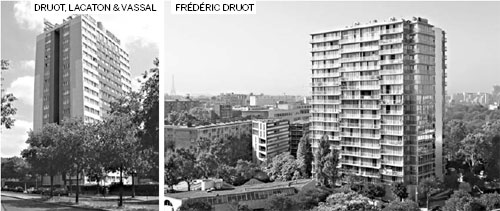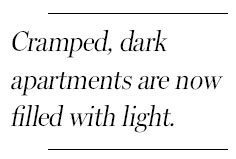A beacon of urban renewal
Updated: 2012-04-15 07:37
(The New York Times)
|
|||||||||||
|
La Tour Bois-le-Pretre was retrofitted at half the cost of tearing it down and rebuilding. Before, left, and after. |
PARIS - Sheathed in new glass balconies and corrugated aluminum panels, La Tour Bois-le-Pretre rises amid decaying cement-and-brick housing blocks.
The tower's makeover, by a team of local architects, is a case study in architectural ingenuity and civic rejuvenation. Instead of replacing the old tower, the designers saw what was worthwhile and added to it.
Retrofitting, it's called. The practice is not common when it comes to large public housing projects. But there have been a few successes. This is one.
Poor neighborhoods on the outskirts of Paris are, as in many cities, dominated by these much-maligned projects from the 1960s and '70s. In Sevran, one of the poorest, hit hard by the rioting that spread across France in 2005, unemployment hovers around 40 percent among the young there. There was a shooting in a kindergarten last year.
French policy favors demolishing Sevran's housing projects. Several have come down, replaced by community gardens, sports fields, new housing and a school. More await destruction.
|
|
President Nicolas Sarkozy has proposed a vast extension of the Paris subway system, to link the city center with dozens of alienated suburbs like Sevran, along with new commercial districts. Employment and growth depend on better access to public transit.
Stephane Gatignon, Sevran's mayor, said: "Urban renovation alone can't solve our problems of unemployment and drugs. But it at least gives us the opportunity to live with more dignity." So it is with La Tour Bois-le-Pretre.
The decaying tower, opened in 1961, was a candidate for demolition, but tenants didn't want to lose their homes. So Paris Habitat, the Paris Office for Public Housing, organized a competition in 2005. The challenge: to repair the infrastructure, upgrade the common spaces and its exterior, and - most radical - add light and space to dark, cramped apartments, without changing the footprint of the building.
Oh, and to spend less money than the cost of tearing the building down and then rebuilding.
Frederic Druot, Anne Lacaton and Jean-Philippe Vassal won with a novel approach.
They would create a shell to envelop the 16-story building. This would extend the apartment floor slabs to add winter gardens, or solariums, and balconies, to bring in lots of light and increase the size of all 96 apartments.
|
|
The proposal included a new lobby; new elevators, kitchens and bathrooms; and many new floor plans. And the tenants wouldn't need to move out for months, or years. This was crucial, because people removed from their homes for long stretches tend not to want to return. The entire retrofit would take less than two years.
The new winter gardens and balconies would be added using prefabricated modules erected like scaffolding around the outside. Punching through the old facade to connect these modules to the apartments would take only one day per apartment, giving residents a new, much larger home, with floor-to-ceiling glass doors opening onto glassed-in winter gardens that gave way to balconies with panoramic views.
And the bill? Little more than half of what demolition and rebuilding would have cost: $15 million, versus $26 million.
The building seems elegant and airy. One tenant griped about the broken elevator, another about the kids who gather in the halls, now full of windows. Sister Ann-Marie Mevellec complained that her kitchen was too small; she missed her old loggia, where she grew vegetables. But she conceded the building was on the whole better. Energy costs have been cut by 60 percent. One tenant, Marie-Jean Benjamin, said, "I'm proud of the building."
The corrugated plastic windows look smart, lower costs and provide privacy. But they also obscure tenants' views.
Those shimmering aluminum panels that cover parts of the facade change color with the hours. But they're hard to keep clean. "We could have done something playful and fashionable on the outside, to look better, if we had put just a few balconies here and there," Ms. Lacaton said. "But our priority was improving the living conditions for everyone."
They have, adding an exemplary landmark to the Paris skyline.
The New York Times
Today's Top News
Rescuers race against time for quake victims
Telecom workers restore links
Coal mine blast kills 18 in Jilin
Intl scholarship puts China on the map
More bird flu patients discharged
Gold loses sheen, but still a safe bet
US 'turns blind eye to human rights'
Telecom workers restore links
Hot Topics
Lunar probe , China growth forecasts, Emission rules get tougher, China seen through 'colored lens', International board,
Editor's Picks

|

|

|

|

|

|








